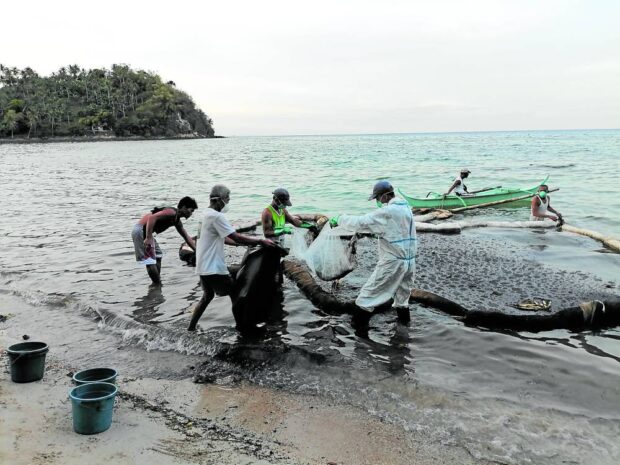Fishers in spill-hit areas lose P19M daily as ban stays

LOCAL EFFORT Villagers in Calapan City, Oriental Mindoro, collect the oil sludge from sunken MT Princess Empress using booms made of coconut husks, fishnets and jute sacks to protect their coastal resources in this photo taken on April 1. The spill continues to take its toll on the livelihood of local fishers. —KALIKASAN PEOPLE’S NETWORK FOR THE ENVIRONMENT PHOTO
CITY OF CALAPAN—Fishermen affected by the oil spill from the sunken MT Princess Empress were losing about P19 million a day due to its adverse impact on their livelihood but the fishing ban in Oriental Mindoro waters would continue until further notice, an official of the Bureau of Fisheries and Aquatic Resources (BFAR) said.
Nazario Briguera, BFAR’s chief information officer, said at least 26,382 fishermen in 14 localities in Oriental Mindoro and some parts of Antique continued to suffer from loss of livelihood due to the widespread oil spill.
The average income loss for a local fisherman was about P714 per day and the BFAR has been searching for alternative fishing grounds to help affected villagers cope with their income loss, Briguera said in a television interview on Wednesday.
Despite this and the low amount of industrial oil found in the samples taken from the waters around Oriental Mindoro, the agency said it wanted to keep the fishing ban in the affected areas.
The BFAR said its initial analyses were still “inconclusive” as far as food safety was concerned even as these results were consistent with the findings of the agency in its first and second batches of analyses.
Both analyses revealed minimal amounts of polycyclic aromatic hydrocarbon (PAH) levels present in seafood collected from sampling sites in Oriental Mindoro, the BFAR said, but it did not indicate the exact figure.
Fish samples collected and analyzed from select sites in Oriental Mindoro on March 10 showed low-level contaminants, or PAH, a class of chemicals that occur naturally in coal, crude oil, and gasoline, the agency noted.
PAH is harmful to humans and other living organisms and may accumulate in the flesh of marine organisms over time.
The BFAR has been monitoring the situation in fishing areas affected by the oil spill from the MT Princess Empress, which sank off the coast of Naujan town on Feb. 28 while carrying 800,000 liters of industrial fuel.
The BFAR has also been evaluating contaminant levels in seafood samples from areas affected by the slick to determine if fish and seaweed are safe for public consumption and if fishing bans should be lifted or imposed by the local government units (LGUs) concerned.
Let BFAR decide
Oriental Mindoro Gov. Humerlito Dolor said in an interview on Thursday that they would take guidance from the BFAR on whether or not the fishing ban would stay in the province.
He said the provincial government and the BFAR have agreed that sampling would be conducted every seven days starting on April 1, with the results to be released “within two to three weeks to guide the LGUs on the continuation or lifting of the fishing ban.”
The sea off the affected towns in Oriental Mindoro and Antique has been cleaned of oil slick but the shoreline cleanup operation, particularly in affected mangrove areas, was still ongoing.
The Philippine Coast Guard (PCG) has so far removed 117,650 kilos of oil debris in offshore and shorelines operations in Oriental Mindoro, Caluya town in Antique, and Taytay town in Palawan, as of April 4, the PCG has reported.
Livelihood aid
A minimal amount of oil sheen reached Verde Island in Batangas City but it was immediately dispersed by the tide or removed by residents.
Seaweeds collected and analyzed from selected sites in Caluya on March 9 also showed low-level contaminants, or PAH, the BFAR said.
Seaweeds and other sessile organisms have greater chances of accumulating PAHs due to their immobility.
As of Thursday, the BFAR said it has allocated P4.4 million as livelihood assistance in the form of postharvest technology packages, which would benefit 10 fishermen’s associations and cooperatives, or 689 families.
Another P1.5 million was also earmarked as food assistance to 5,000 affected fishers in Mimaropa (Oriental Mindoro, Occidental Mindoro, Marinduque, Romblon and Palawan), while P580,500 was spent to help displaced fishing groups in Western Visayas, mainly those in Antique.
READ: Fishers’ group calls for subsidy for oil spill-affected fishing families